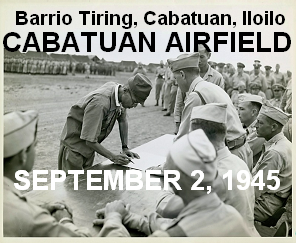
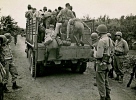
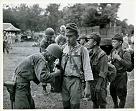
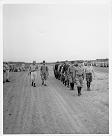
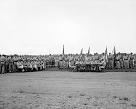
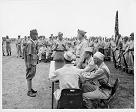
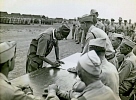
Col. Ryoichi Tozuka signs the surrender instrument
as Col. Raymond G. Stanton looks on.
Cabatuan Airfield
Barrio Tiring, Cabatuan, Iloilo
Panay Island, Philippines, September 2, 1945
|
|
- o -
|
![(above) Weapons from the Tozuka Unit's 3rd
Company displayed at the Museo Iloilo.
Samples of military money [gumpyo = 'Mickey
Mouse' money] may be seen at the back.<br><br>
(center, left) JA tochika [pillbox] still standing
along the Suage River in Janiuay, Iloilo<br><br>
(center right) Japanese flag and samurai
sword exhibited in the Museo Iloilo. On the
right is an aerial bomb<br><br>
(bottom) Tomb of Francisco Offemaria.
Behind it is the tomb of the Unknown Soldier.
In the background are the graves of Filipino
guerrillas killed in action at what is now
the Balantang Memorial Cemetery
National Shrine (BMCNS) in Jaro,
Iloilo City](http://www.cabatuan.com/kumai/the-blood-and-mud-in-the-philippines-toshimi-kumai-page004a.png)
(above) Weapons from the Tozuka Unit's 3rd
Company displayed at the Museo Iloilo.
Samples of military money [gumpyo = 'Mickey
Mouse' money] may be seen at the back.
(center, left) JA tochika [pillbox] still standing
along the Suage River in Janiuay, Iloilo
(center right) Japanese flag and samurai
sword exhibited in the Museo Iloilo. On the
right is an aerial bomb
(bottom) Tomb of Francisco Offemaria.
Behind it is the tomb of the Unknown Soldier.
In the background are the graves of Filipino
guerrillas killed in action at what is now
the Balantang Memorial Cemetery
National Shrine (BMCNS) in Jaro,
Iloilo City
|
|
CHAPTER 5 – NIGHT ATTACKS
5.1 Surrender of the Deputy Governor
Captain Watanabe did not intend to trust the peoples’ false allegiance. He sent his men wherever there was a hint that it might be a guerrilla base, arrested citizens and tortured them. One time he gathered some locals at one house and beheaded them all. Blood flew out on the street. Following this, a few fear-stricken residents volunteered to guide the forces to the headquarters of Colonel Peralta’s 6th Military District and Lieutenant Colonel Luis Dator’s 64th Regiment in the mountains several kilometers west of Sara.
When we arrived at the area, Captain Watanabe gathered the residents and ordered them to locate the wireless radios hidden nearby. About 200 to 300 people were forced to stand in line in the forest with armed Japanese soldiers behind them. Systematically, with a bamboo stick or piece of wood in hand, as on a treasure hunt, they searched the grounds for any signs of wireless radio sets in the wooded area. After finishing one spot, they were directed to move on to another. Their thorough examination finally yielded enough parts to make several wireless radio units. Captain Kengo Watanabe was bursting with pride. He wired Colonel Hidemi Watanabe that he had seized several wireless units of the enemy. Within this area, he also captured Lieutenant Colonel Cesar Roces, chief of the supply unit (G4) of the 6th Military District. Lieutenant Colonel Roces was a very wealthy man of Jaro and was the highest-ranking guerrilla officer whom we captured.
In the pursuit of these war operations, Captain Watanabe was impatient and tended to claim credit of the results for himself. He became surly when his subordinates claimed more accomplishments. He himself led the undertaking when the intelligence information obtained was likely to bring favorable outcomes. He ordered 1st Lieutenant Hajime Fujii and myself to supporting roles or assigned us to areas where no good results were expected. I tried to overcome this behavior of Captain Watanabe in ways very different from the threats and intimidation that he adopted. In my platoon, I tried to make myself available for people who had already shown allegiance. They could approach me without fear of harm even if they were following guerrilla instructions. At our station at the Sara Elementary School, I set up two bamboo poles and attached a wire between the top ends. I saw to it that the constant key-tapping sound of the wireless radio streamed out from the room below. It thus appeared that this garrison was the control tower of the whole Panay punitive operation.
More often than not, I gathered the people and smilingly tried to persuade them: ‘The goal of the Japanese Army is the surrender of Colonel Peralta, Lieutenant Colonel Dator and the Deputy Governor Jose Aldeguer. If any guerrillas surrendered with their weapons, we will not harm them. If we accomplish this goal, we will stop the punitive operation immediately. However, the punitive actions will not stop until we accomplish our aim. Tell the guerrillas what I’ve said.’ I repeated this speech for two days, wondering if the plan would work. On the 3rd or 4th day, the results began to show. Many residents came along to express their allegiance and submitted their hand-made pistols or rifles. I jotted down the names of their village in my notebook and gave them certificates in Japanese that said, ‘I certify that your village has surrendered to the Japanese Army.’ This news spread from village to village and representatives of villages came in groups to hand over their hidden weapons. I secretly sent several soldiers to villages I that did not volunteer allegiance and ordered them to set fire to one or two huts while warning the leaders, ‘Your village has not yet surrendered to the Japanese Army.’ The elementary school was continuously full of the locals who brought in their weapons. All this time, I made it a point to keep on the–wireless key tapping.
We collected about 700 to 800 weapons; most were fine hand-made ones and we shuddered to think if they been used on us. With the villagers, I did my best to act as a close friend, sharing precious tobacco and so on. They must have been reassured, and the headmen of the towns of Sara, Ajuy, and San Dionisio surrendered to me one after another. Eventually, an impressive-looking man showed up. His name was Victoriano Salcedo – a member of Congress before the war, a political leader of Iloilo province as well as a large landowner in Sara –
the so-called ‘boss’ of the area. I showed him the organizational list of the guerrillas that I had picked up from a basket the previous day, saying, ‘My Filipino spies even got into the guerrilla headquarters and stole these papers for me.’ Then I politely asked him to cooperate with us, though also threatening with the information I had on the leaders and residents of Sara who had cooperated with the guerrillas. After a few meetings, he promised me, ‘I am the godfather of Lieutenant Colonel Dator, and Deputy Governor Aldeguer is my son-in-law. I will try to make them yield.’ He seemed to have succeeded since a few guerrilla officers and soldiers did surrender with their rifles.
From my daily reports, the number of guerrillas who gave up the fight and submitted their weapons to me surprised Battalion Commander Tozuka. Captain Watanabe, however, was not happy about this. For one thing, the reports were presented to the Battalion Commander and not to him. Also, the results exceeded his. Indeed, prompted by men’s pride in themselves, there was great competition among the troops during the punitive operations.
Mr. Salcedo said he could not contact Lieutenant Colonel Dator as he did not know where he was, but he would certainly get Deputy Governor Aldeguer to capitulate. By the beginning of October, as my unit had moved to the next target area of San Dionisio, he surrendered with Aldeguer as promised. I reported his surrender to both the unit commander and Captain Watanabe. Colonel Tozuka praised me highly, but Captain Watanabe just glared at Aldeguer and me with the bitterest expression on his face.
Around a dozen guerrilla soldiers were set free after they vowed to cooperate with us from then on. I took Deputy Governor Aldeguer, Mr. Salcedo, the mayor of Sara, and high-ranking guerrilla officers to Iloilo City by boat. On the way, Aldeguer said to me, ‘I’m glad I surrendered to you. If it were Captain Watanabe he would have killed me.’ I decided to leave Aldeguer and Salcedo with Governor Caram who was the Japanese appointed governor and sent the guerrilla officers to the POW camp at Fort San Pedro. Captain Watanabe became even more hostile towards me since I had left Aldeguer with Caram without consulting him. Thus, the relationship between us became worse. (After the war, Aldeguer became one of the congressional representatives for Iloilo Province).
As soon as our unit at San Dionisio received new supplies of food and ammunition, we started punitive operations in the eastern and central parts of Capiz Province where Lieutenant Colonel Braulio Villasis led the 66th Regiment. By then, it was already in the middle of the rainy season of Panay. The heavy rains and strong winds hindered our operations.
|
|